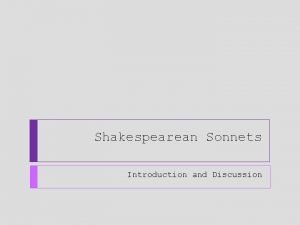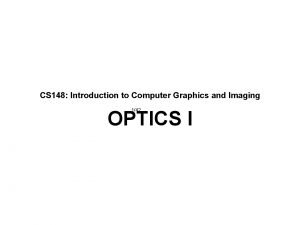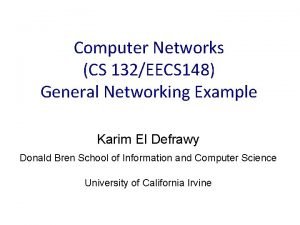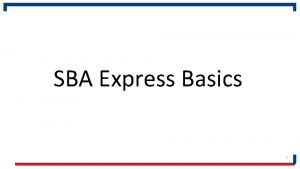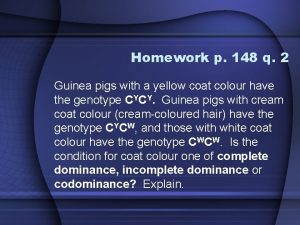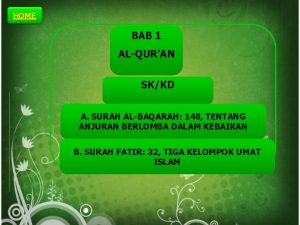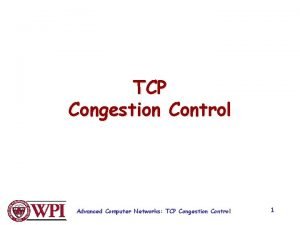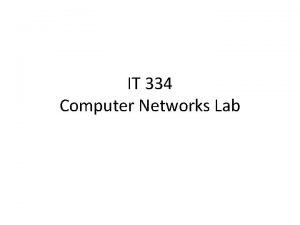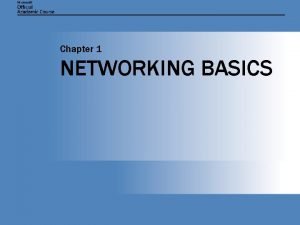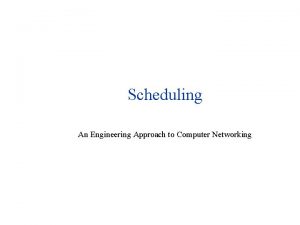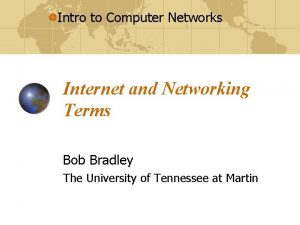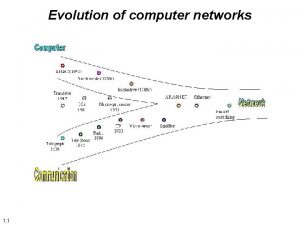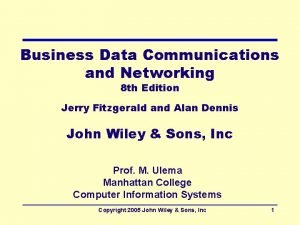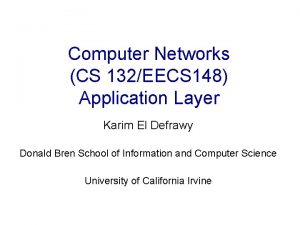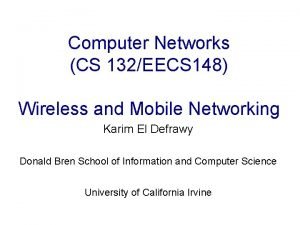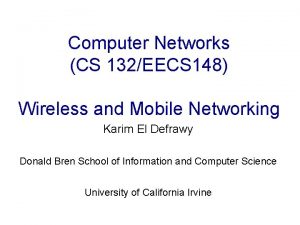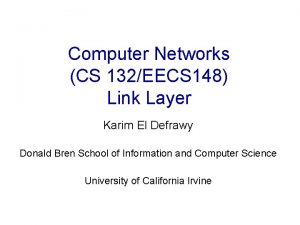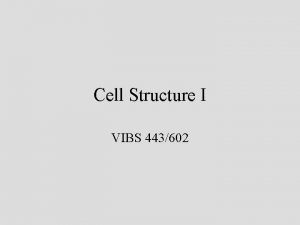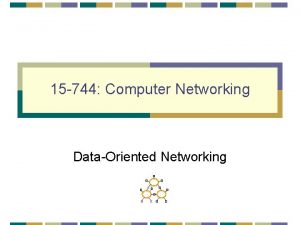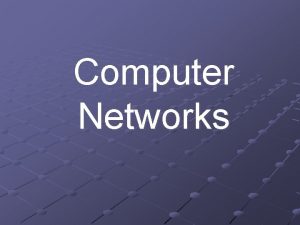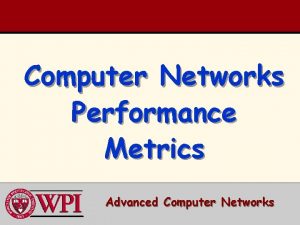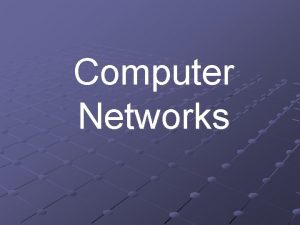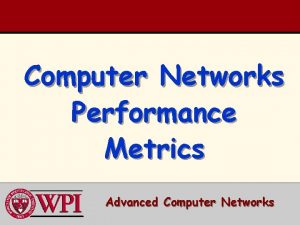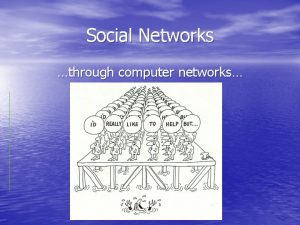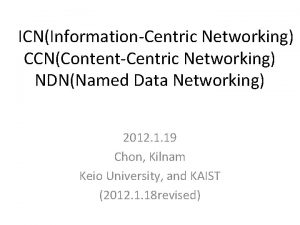Computer Networks CS 132EECS 148 General Networking Example

























- Slides: 25

Computer Networks (CS 132/EECS 148) General Networking Example Karim El Defrawy Donald Bren School of Information and Computer Science University of California Irvine

Overview of General Networking Concepts • Protocol Architecture • Protocol Layers • Encapsulation • Network Abstractions 2

Sending a packet from Argon to Neon 3

128. 143. 71. 21 is not on my local network. Sending a packet from Argon to Neon Therefore, I need to send the packet to my 128. 143. 71. 21 on my local network. default gateway withisaddress 128. 143. 137. 1 DNS: The is IPisthe address of Therefore, I can send the packet directly. ARP: What the. IPMAC of“neon. tcpip-lab. edu”? is address 128. 143. 137. 1? ARP: Theof. MAC address of 128. 143. 71. 21 128. 143. 137. 1 is 00: e 0: f 9: 23: a 8: 20 ARP: What is the MAC ARP: Theof. MAC address of address 128. 143. 71. 21? 128. 143. 137. 1 is 00: 20: af: 03: 98: 28 frame 4 frame

Communications Architecture • The complexity of the communication task is reduced by using multiple protocol layers: • Each protocol is implemented independently • Each protocol is responsible for a specific subtask • Protocols are grouped in a hierarchy • A structured set of protocols is called a communications architecture or protocol suite or stack 5

TCP/IP Protocol Suite • The TCP/IP protocol suite is the protocol architecture of the Internet • The TCP/IP suite has four layers: Application, Transport, Network, and Data Link Layer • End systems (hosts) implement all four layers. Gateways (Routers) only have the bottom two layers. 6

Functions of the Layers • Application Layer: – Service: Application specific (delivery of email, retrieval of HTML documents, reliable transfer of files) – Functions: Application specific • Transport Layer: – Service: Delivery of data between hosts – Functions: Connection establishment/termination, error control, flow control • Network Layer: – Service: Move packets from source host to destination host – Functions: Routing, addressing • Data Link Layer: – Service: – Functions: 7 Reliable transfer of frames over a link Media Access Control on a LAN Framing, media access control, error checking

TCP/IP Suite and OSI Reference Model The TCP/IP protocol stack does not define the lower layers of a complete protocol stack 8

Assignment of Protocols to Layers 9

Layered Communications • An entity of a particular layer can only communicate with: 1. a peer layer entity using a common protocol (Peer Protocol) 2. adjacent layers to provide services and to receive services 10

Layers in the Example 16

Layers in the Example Send HTTP Request to neon Frame is an IP datagram Establish a connection to 128. 143. 71. 21 at port 80 Open TCP connection to 128. 143. 71. 21 port 80 IP datagram is a TCP segment for port 80 Send IP data-gram to Send a datagram (which contains a connection Send IP datagram to 128. 143. 71. 21 request) to 128. 143. 71. 21 Frame is an IP datagram Send the datagram to 128. 143. 137. 1 Send Ethernet frame to 00: e 0: f 9: 23: a 8: 20 17 the datagram to 128. 143. 7. 21 Send Ethernet frame to 00: 20: af: 03: 98: 28

Layers and Services • Service provided by TCP to HTTP: – reliable transmission of data over a logical connection • Service provided by IP to TCP: – unreliable transmission of IP datagrams across an IP network • Service provided by Ethernet to IP: – transmission of a frame across an Ethernet segment • Other services: – DNS: translation between domain names and IP addresses – ARP: Translation between IP addresses and MAC addresses 18

Encapsulation and Demultiplexing • As data is moving down the protocol stack, each protocol is adding layer-specific control information 19

Encapsulation and Demultiplexing in our Example • Let us look in detail at the Ethernet frame between Argon and the Router, which contains the TCP connection request to Neon. • This is the frame in hexadecimal notation. 00 e 0 0800 8 bff 0050 2000 20 f 923 4500 808 f 0009 598 e a 820 002 c 8990 465 b 0000 00 a 0 9 d 08 808 f 0000 0204 2471 4000 4715 0000 05 b 4 e 444 8006 065 b 6002

Encapsulation and Demultiplexing 21

Encapsulation and Demultiplexing: Ethernet Header 22

Encapsulation and Demultiplexing: IP Header 23

Encapsulation and Demultiplexing: IP Header 24

Encapsulation and Demultiplexing: TCP Header Option: maximum segment size 25

Encapsulation and Demultiplexing: TCP Header 26

Encapsulation and Demultiplexing: Application data No Application Data in this frame 27

Different Views of Networking • Different Layers of the protocol stack have a different view of the network. This is HTTP’s and TCP’s view of the network. 28

Network View of IP Protocol 29

Network View of Ethernet • Ethernet’s view of the network 30
 Difference between virtual circuit and datagram networks
Difference between virtual circuit and datagram networks Backbone networks in computer networks
Backbone networks in computer networks Traditional network vs sdn
Traditional network vs sdn Shakespeare sonnet introduction
Shakespeare sonnet introduction Psalm 148:1-14
Psalm 148:1-14 Http 148 215 servsoc inicio
Http 148 215 servsoc inicio Cs 148
Cs 148 Eecs 148
Eecs 148 Crónica de d joão i capítulo 115 resumo
Crónica de d joão i capítulo 115 resumo Psaume 135 chanté
Psaume 135 chanté Sba servicing sop
Sba servicing sop One pumch man 148
One pumch man 148 Homework 148
Homework 148 Al baqarah 148
Al baqarah 148 P 148
P 148 Difference between bit stuffing and byte stuffing
Difference between bit stuffing and byte stuffing Error detection in computer networks
Error detection in computer networks Jacobson/karels algorithm
Jacobson/karels algorithm Networking practical exercises
Networking practical exercises Lan basics
Lan basics An engineering approach to computer networking
An engineering approach to computer networking Computer networking terms
Computer networking terms Evolution of computer networking
Evolution of computer networking Computer networking 8th edition
Computer networking 8th edition Analogue and digital transmission in computer networks
Analogue and digital transmission in computer networks Computer networks kurose
Computer networks kurose



